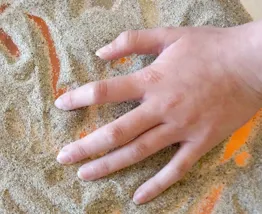Food Refusal? Try Food Exploring!

Have you ever sampled a new food and it didn’t taste or feel the way you were expecting it to? That can be an unpleasant experience…because you had specific expectations for that food before you ate it.
We make judgements about food based on what it looks like, how it smells, how it feels in our hands, and whether we’ve eaten it—or something like it—before.
Now imagine that your sensory or motor system isn’t working optimally. You can’t be sure you’re going to be able to chew that food or move it around in your mouth. You’re afraid it will make you gag or choke. You have no idea what it will feel like in your mouth. Of course, you’re going to refuse to try to eat.
The fact is, food is variable. Those two apples on the counter may look similar but they may taste very different—or feel very different in your mouth. It’s hard to predict. That’s why fast food is so easily accepted by children with feeding disorders—it’s EXACTLY the same every time. No guesswork, no surprises.
So, what’s a feeding therapist to do?
Well, we can start by helping our clients create positive expectations about food through food exploration. In other words, let’s learn about the food BEFORE we put it in our mouth.
Here are seven tips to help with food exploration:
Food is unpredictable (outside of McDonald’s that is!). Let’s try to make it less so by being good food explorers! For more tips, register for my upcoming Complex Feeding & Swallowing Problems in Children seminar here.
We make judgements about food based on what it looks like, how it smells, how it feels in our hands, and whether we’ve eaten it—or something like it—before.
Now imagine that your sensory or motor system isn’t working optimally. You can’t be sure you’re going to be able to chew that food or move it around in your mouth. You’re afraid it will make you gag or choke. You have no idea what it will feel like in your mouth. Of course, you’re going to refuse to try to eat.
The fact is, food is variable. Those two apples on the counter may look similar but they may taste very different—or feel very different in your mouth. It’s hard to predict. That’s why fast food is so easily accepted by children with feeding disorders—it’s EXACTLY the same every time. No guesswork, no surprises.
So, what’s a feeding therapist to do?
Well, we can start by helping our clients create positive expectations about food through food exploration. In other words, let’s learn about the food BEFORE we put it in our mouth.
Here are seven tips to help with food exploration:
- Look at the food. What color is it? What shapes do you see? Does it look wet or dry? Does it look soft or crunchy?
- Touch the food. Does it feel bumpy or smooth? Do all parts of the food feel the same? Is it cold or warm? Were you right about how wet or dry it is? How do you think it will feel in your mouth?
- Smell the food. What do you smell? Does it smell like anything you’ve had before? Does it smell strong or not so strong?
- “Kiss” the food. How does it feel against your lips? Do you taste anything? Is it wet or dry? Bumpy? Smooth? Cold?
- Take a lick. Were you right about how it tastes? Do you taste sweet? Salty? Is it cold or warm in your mouth? Does it taste like anything you’ve had before?
- Hold it between your teeth. Is it soft or hard? What do you taste? Can you bite through it easily or is it hard to bite?
- Take a tiny “mouse” bite. Were you right about how it tastes? How it feels? Is it easy to chew?
Food is unpredictable (outside of McDonald’s that is!). Let’s try to make it less so by being good food explorers! For more tips, register for my upcoming Complex Feeding & Swallowing Problems in Children seminar here.





